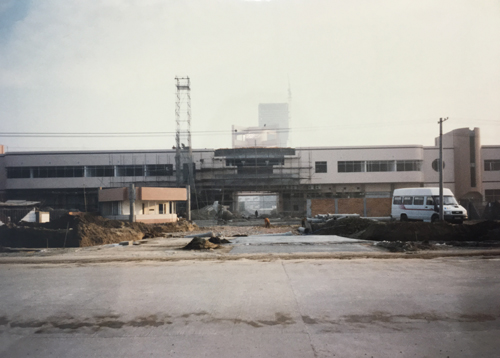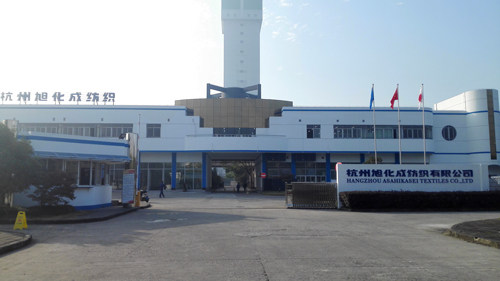100 Stories1995 Becoming a Trusted Japanese Company with Chinese Employees
Asahi Kasei's business in China began with the establishment of the Beijing Office in 1988. Then, with the establishment of the Shanghai office in 1995, the company's expansion into China began in earnest. Various businesses, including textiles, medical, water treatment, engineering plastics, and chemicals, were set up and put into operation at multiple production bases in Hangzhou, Suzhou, Zhangjiagang, Nantong, and elsewhere.
One of the businesses they in China that was developed after much hard work was the production of Roica, a spandex fiber with excellent elasticity. This was all new to the Asahi Kasei Group, with Hangzhou Asahikasei Textiles Co., Ltd. (HAT), which started operation in 1997 as a knitting and dyeing plant using Roica yarn, and Hangzhou Asahikasei Spandex Co., Ltd. (HAS) which started the production of Roica yarn in 2003.
In the 1990s, apparel companies were Asahi Kasei customers in the textile business, but the textile business as a whole was expanding into China as a production base. There was then an active movement that “we should also expand our business there,” and the Roica business was also considering this possibility.
The establishment of HAT originally began when a major innerwear apparel company approached Asahi Kasei about establishing a manufacturing base in China. In order to get the business off the ground in a short period of time, we considered seeking cooperation from local capital in China, but the project members insisted on creating a corporate entity funded solely by Japanese companies, believing that it was important in the long run to be able to manage the business flexibly on their own terms, even if it was difficult at first.
How could this be achieved? At the time, team members had no experience or knowledge of launching a factory in China, so they decided to proceed with the Roica project through co-creation with a Japanese company that had knowledge of the industry. The company sought cooperation from various Nikkei companies, including a major dyeing company in Kanazawa for dyeing, a company specializing in knitted fabrics in the Sanin region for knitting, and a major Japanese trading company for logistics and other local support, to acquire expertise in business development in China and to introduce technology and human resources. As per the initial goal of the establishment, the company is not a joint venture with a Chinese company, but a company whose share composition is 100% Japanese-affiliated and can be operated at the will of Asahi Kasei.
At the same time, for the construction of the plant, a major Japanese general contractor was hired to supervise the construction work, but a local design company was hired for the design. The reason for this was to make the building easy to use locally. It is a funny story now, but some people after it was built, the Japanese division asked, “Why did you design a building that wasted so much land?”
Later, when HAS was established in 2003 as Roica production base, we utilized our knowledge of yarn manufacturing and the experience of the members who launched HAT to design a building that was 100% Asahi Kasei capital and used the land efficiently.
The person in charge looks back on those days when everything was in a state of exploration. “Investment companies now provide support for business startups, but at that time we did not have a well-developed admin team, and the business members worked very hard to handcraft what was needed outside of the legal department's support. “
The Chinese members, then employees of the Shanghai office and now of Asahi Kasei China, felt strongly about the fundamental cultural differences between Chinese and Japanese, and often acted as intermediaries between expatriates and local staff. The most common differences were the unstated working rules of dress and behavior, which were commonplace to the Japanese but out of place to the Chinese.
In particular, the prohibition of private conversation in the workplace does not exist in China. In a quiet workplace with many Japanese, Chinese staff sometimes complained that they felt they could not communicate and that human relations in the workplace were stifling.
Thus, business expansion in China has been a struggle to understand the cultural differences between China and Japan, and to find areas where mutual concessions can be made to create a comfortable workplace.
The Shanghai office became Asahi Kasei Management (Shanghai) Co., Ltd. in 2007. Furthermore, in 2015, a regional control company, Asahi Kasei (China) Co., Ltd., was established to bring the local subsidiaries of the Asahi Kasei Group in China under its umbrella. The services offered include financing, financial accounting, human resources, IT, public relations, legal, intellectual property, and environmental safety. In addition, several senior executives over the past few years have been Chinese nationals. Not only the general manager of the local subsidiary, but also the head of the legal department and the head of the environmental and safety department of the investment company are also Chinese.
As of March 2022, Asahi Kasei's Chinese operations consisted of approximately 20 local subsidiaries with approximately 2,000 employees.





